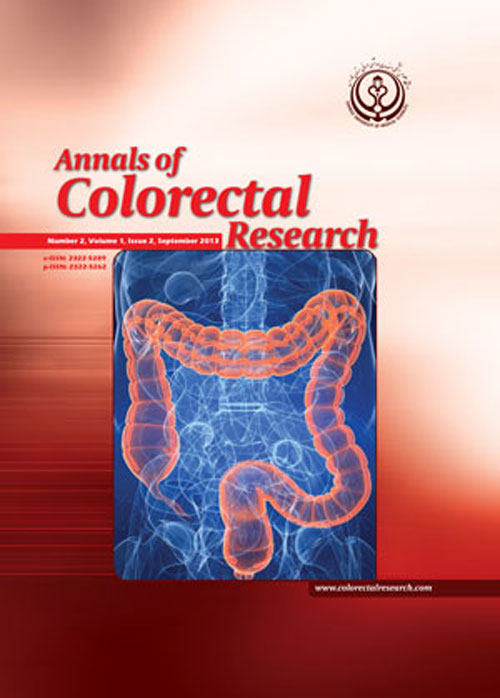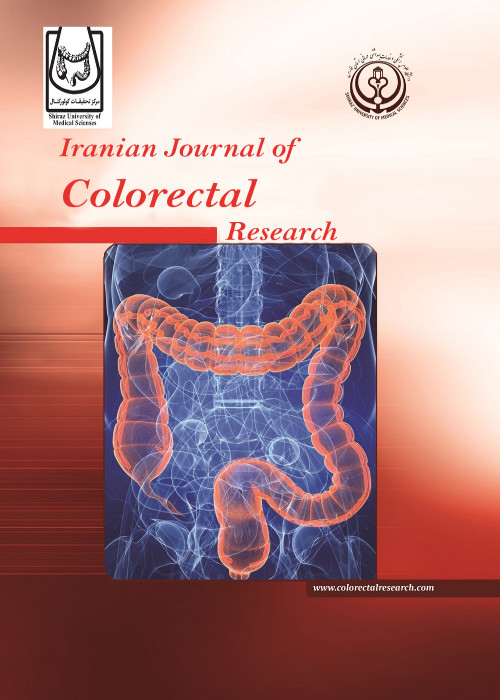فهرست مطالب

Iranian Journal of Colorectal Research
Volume:2 Issue: 4, Dec 2014
- تاریخ انتشار: 1394/02/22
- تعداد عناوین: 5
-
-
Page 1Background
Ulcerative colitis (UC) is a form of inflammatory bowel disease (IBD). There are several chemical and herbal drug regimens for treatment of UC..
ObjectivesThe aims of this study were to investigate the effects of Hypericum perforatum on histopathological and tissue malondialdehyde (MDA) level of colonic tissue in rat with induced UC..
Materials And MethodsTwo milliliters of 3% acetic acid was administered into the colon to induce UC. Seventy rats were divided into seven equal groups. Groups I and II received 1 mL of 600 and 300 mg/kg H. perforatum extract orally per day respectively; groups III and IV received 1 mL of 20% and 10% intra-colonic gel form of H. perforatum extract daily respectively; group V as positive control received 2 mL of intra-colonic asacol; group VI was a negative control receiving 0.5 mL/kg of normal saline after induction of UC; group VII received just intra-colonic gel base. All the animals were evaluated for histological changes and tissue MDA level seven days after the treatment..
ResultsH. perforatum extract in the two forms of trans-rectal and oral administration on the seventh day after the therapy could result in a more healing effect on acetic acid-induced damaged colonic tissue with a reduction in the MDA activity. In trans-rectal administration, the 20% gel form had a better healing response than the 10% gel form and was prominently more effect on the seventh day of the therapy. In oral administration of strawberry extract, the 600 mg/kg dosage had a better healing response than the 300 mg/kg and was significantly more effective on the seventh day of therapy..
ConclusionsSo H. perforatum may be considered as a treatment of choice for UC especially in gel form to broaden the current therapy options of the disease..
Keywords: Hypericum perforatum, Inflammatory Bowel Disease, Ulcerative Colitis, Malondialdehyde -
Page 2BackgroundSelective conservative management of abdominal penetrating trauma can significantly minimize the morbidity and length of hospitalization by decreasing the rate of unnecessary laparotomies..ObjectivesIn the present study, we reported the outcome of newest guidelines of our trauma center in one year..Patients andMethodsAll patients with anterior abdominal stab wounds who were referred to Rajaiee trauma center between September 2012 and September 2013 were enrolled. Patients without shock, peritonitis, and evisceration who did not require emergency operation were planned for nonoperative management with serial physical examinations, blood cells count, and radiographic investigations. Outcome of nonoperative management was described in order to reveal the advantages and disadvantages of our current guideline..ResultsAmong 45 patients who underwent nonoperative management, 27 cases (60%) required laparotomy due to peritonitis or shock. Rate of unnecessary nontherapeutic operations was 49.2%..ConclusionsMinimizing diagnostic procedures such as diagnostic peritoneal lavage and computed tomography can significantly increase the rate of unnecessary operations leading to longer hospitalizations and operation-related morbidity. To reduce the failure rate of nonoperative management and nontherapeutic surgeries, modifications in current guidelines should be made..Keywords: Wounds, Abdomen, Trauma
-
Page 3IntroductionForamen of Winslow hernia is a rare occurrence, accounting for only 8% of all internal hernias and 0.08% of all hernias. It presents a diagnostic challenge with subtle clinical and radio - logical features. A delay in treatment is responsible for high mortality rates of around 36 - 49%..Case PresentationHere we describe a case of a 31-year-old man who presented with acute epigastric pain. Extensive diagnostic work - up suggested foramen of Winslow hernia. At laparotomy, the herniated small bowel was viable and reduction was achieved with gentle traction..ConclusionsSuccessful management of foramen of Winslow hernia requires prompt diagnosis and surgical treatment..Keywords: Small Intestine, Hernia, Peritoneal Cavity
-
Page 5IntroductionIntussusception is telescoping or invagination of one part of the intestine (intussusception) into an adjacent section (intussuscipiens) and it may present as a life threatening condition. Intussusception is so rare in adults and small intestine intussusception in adults is usually due to benign entity; whereas in large intestine, malignant neoplasms can be the etiology. Here, we reported a rare case of adult jejunojejunal intussusception due to a jejunal villous adenoma polyp in an Iranian female patient..Case PresentationA 33-year female Iranian patient referred to emergency department in Gastroenterology and liver diseases Research Center, Shahid Beheshti University of Medical Sciences with extreme abdominal pain, nausea and constipation. Plain abdominal computed tomography (CT) scan revealed a mass suggesting intussusception in the jejunum. Balloon association enteroscopy showed two 10 mm and 40 mm polyps in jejunum. The polyp was a villous adenoma confirmed by pathology. Exploratory laparotomy revealed jejunojejunal intussusceptions and exploratory laparotomy with jejunoileal anastomosis was performed..ConclusionsNonspecific symptoms of an adult intussusception might result in a late diagnosis and imaging modalities including CT scan play a significant role in the diagnosis. Surgical operation is the best treatment in adult intussusception leading to the best results..Keywords: Intussusception, Surgery, Villous, Tomography


